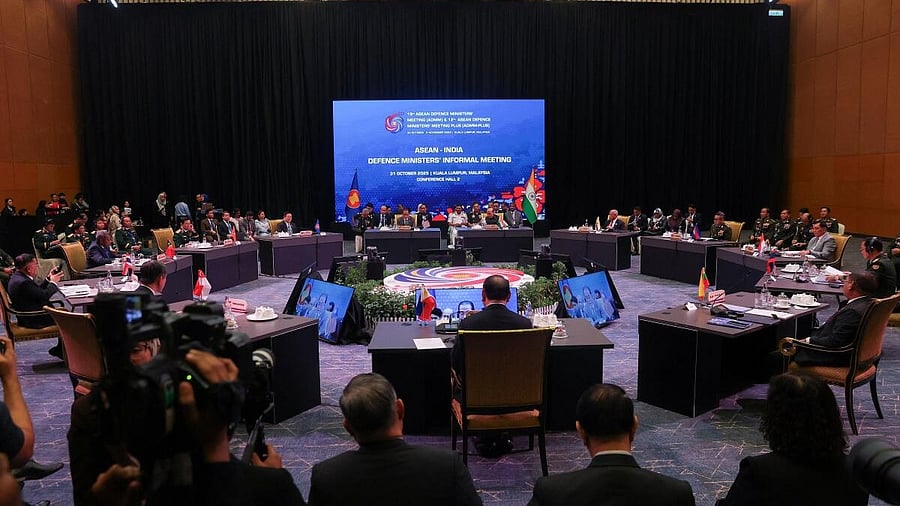
Association of Southeast Asian Nations (ASEAN) Defence Ministers Meeting
Credit: Reuters Photo
The signing of a 10-year ‘Framework for the US-India Major Defence Partnership’ in Kuala Lumpur, on October 31, marks a defining moment in India’s evolving strategic trajectory.
It is not merely a ceremonial renewal of co-operation, but a forward-looking blueprint intended to align the two democracies in defence production, technology sharing, and regional deterrence through the next decade. The timing — amid trade frictions and global realignments — adds depth to its geopolitical resonance.
A broader strategic canvas
The Kuala Lumpur pact provides overarching policy direction for defence co-operation, spanning intelligence sharing, joint military exercises, co-development of advanced systems, and enhanced interoperability between the armed forces of the two nations. It builds upon earlier foundational agreements such as LEMOA, COMCASA, and BECA, which together allow India and the United States to operate more cohesively across sea, air, and land domains. This institutionalisation of defence ties now enters a phase of policy predictability — a rare commodity in contemporary global politics.
For India, the framework signals a deliberate tilt toward strategic diversification. While its historical dependence on Russia remains, the steady infusion of US systems — from surveillance drones to heavy-lift helicopters — reflects a recalibration of military doctrine.
India’s strategic payoff
For India, the agreement strengthens its quest for defence self-reliance. The US has already emerged as India’s third-largest defence supplier, and the new roadmap is expected to deepen technology transfer, joint R&D, and industrial collaboration. The Kuala Lumpur framework could create manufacturing jobs in India and reduce New Delhi’s dependence on imported systems.
India’s defence posture will also gain deterrent depth in the Indian Ocean and the Indo-Pacific theatre. The integration of US drones and helicopters with existing naval assets will give India a sharper edge in countering Chinese naval intrusions and securing sea lanes critical for energy imports.
Washington’s strategic calculus
For the US, the pact is a strategic investment in preserving its influence in Asia amid the shifting balance of power. Washington strengthens its foothold in South Asia without committing large-scale troop deployments.
The US also gains economic leverage through steady, high-value defence exports that sustain its military-industrial complex. Furthermore, a technologically capable India serves as a counterweight to China, and a stabilising partner for regional democracies.
Impact on Asia’s security geometry
The timing of the pact underscores its regional messaging. It signals an emerging trilateral equilibrium involving India, the US, and ASEAN states, committed to resisting coercive maritime behaviour in the South China Sea, and promoting rule-based navigation.
The pact indirectly strengthens the Quad framework, reinforcing India’s position as an indispensable player in Indo-Pacific security. For Southeast Asian nations wary of Chinese assertiveness, the India-US synergy offers an alternative security umbrella that doesn’t formally resemble a military bloc but delivers credible deterrence.
Strategic ripples
China’s growing military presence in the Indian Ocean, its fortified bases in Djibouti and potential in Gwadar, and its assertiveness along the Line of Actual Control make India’s maritime modernisation a direct counterbalance.
Islamabad will perceive this deepening defence partnership as a narrowing of space in Washington’s regional calculus. Pakistan’s reliance on Chinese equipment and financing is likely to grow, pushing the region toward a more bipolar military alignment.
The Russia factor
Will the US-India framework erode New Delhi’s long-standing defence ties with Moscow? The answer lies in a gradual transition rather than an abrupt rupture. Russia still accounts for roughly 36% of India’s defence imports, though its share has declined from nearly 70% a decade ago.
Western sanctions on Russia following the Ukraine war, coupled with supply chain disruptions, have accelerated India’s diversification. India will likely maintain a calibrated balance — keeping its Russian ties alive to preserve strategic autonomy, even as the US relationship deepens.
The deeper challenge for India will be to manage its partnerships without becoming a junior partner in any bloc — strategic convergence must not translate into strategic dependence. India’s credibility as an autonomous power rests on its ability to align interests without surrendering decision-making sovereignty.
A decade of testing and opportunity
The 10-year roadmap is both a promise and a test. It promises unprecedented access to technology and interoperability, but it also tests India’s diplomatic dexterity in balancing multiple power centres. For Washington, the success of this partnership will hinge on sustaining bipartisan support for India, even amid trade disputes and shifting global priorities.
This defence pact is a strategic bridge — linking India’s aspirations for self-reliance with the US’ quest for regional stability. Its true measure will be in how effectively the two nations convert this convergence into enduring security, balanced deterrence, and regional peace.
K S Tomar is a Shimla-based senior political analyst. X: @Toruhp.
Disclaimer: The views expressed above are the author's own. They do not necessarily reflect the views of DH.